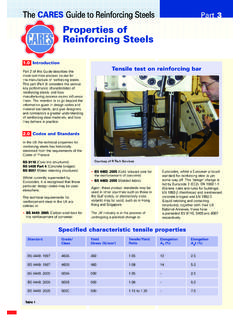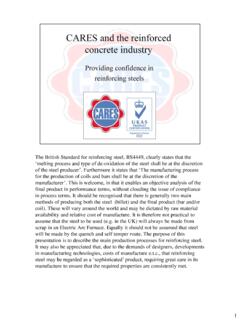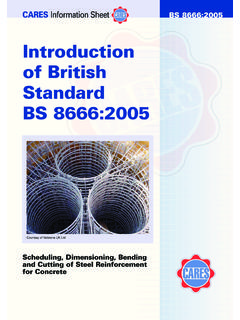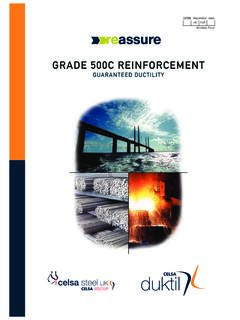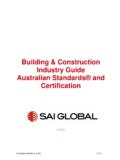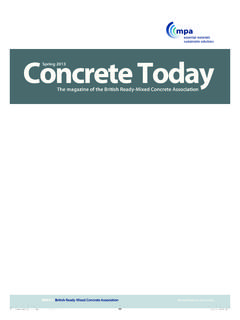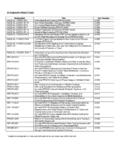Transcription of Standards, Codes and Regulations - Certification …
1 TheCARESG uide to reinforcing SteelsPart10 standards , Codes and Regulationscommittee as a standard. The sameapplies to BS5400 and BS8007 and anyassociated standards that werewithdrawn. The workmanshiprequirements of BS8110 are nowincluded in another standard, BS EN13670, Execution of Concrete the UK, concrete is covered byBS8500:Concrete complimentaryBritish Standard to BS EN various Eurocodes, as well as theproduct and execution standards , havebeen produced by CEN (Comit Europ en de Normalisation), whichpublishes these as full EuropeanStandards.
2 Under CE rules, all Nationalcodes that conflict with the Eurocodesmust be the period within which BS 8110and EC2 co-exist, it is important to createa similar path for the use of each, withtheir respective supporting production of a European standardfor reinforcing steels began in key stumbling block to bringingwhat may be regarded as a normal European standard to fruition remainsthe inability to agree a common set ofsteel grades and associated barmarking. This problem still exists, andthe current European standard EN10080, is an open standard, withno steel grades.
3 The process wasfurther interrupted by the requirementfor the standards committee to accountfor the requirements placed upon it bythe Construction Products Regulation,which required the standard to bestructured in such a way as to enablethe application of the CE Marking,including the associated is termed harmonisation .Running in parallel to this process wasthe creation of a European Concretedesign code , BS EN 1992-1-1,Eurocode 2, Design of ConcreteStructures, which provides the basedesign specification for the Europeanproduct standards . This has now beenissued, superceding the UK s Nationaldesign code , BS8110, Structural use ofconcrete code of practice for designand construction.
4 One key aim was to ensure that apackage of European Codes andstandards was issued at approximatelythe same time, thereby enabling asmooth transition to emerging codesand standards , bearing in mind theirinterdependence. Despite the delay inissuing a harmonised EuropeanStandard for reinforcing steels, BS4449,BS4483 and BS8666 were re-issued in2005, correlating with the draft of BSEN10080 at that time. Whilst this suiteof documents is being usedsuccessfully, it must be stressed thatthe operation of sound managementsystems throughout the concretesupply chain will ensure that old and new standards and Codes will be ableto be run successfully in parallel for aperiod of part of the CARES Guide describesthe key differences between the old and new systems, showing how theycan be used during any continuing co-existence period.
5 It also describes thekey area of CE marking and the strategyto be employed by CARES and itsapproved firms to ensure thatconstruction clients and designersreceive the appropriate reinforcing steelfor their particular GeneralEurocode 2 was introduced into the UKin 2010 and its use, as consideredappropriate, will dramatically affect theway concrete structures are will include the use of steelreinforcement. BS8110 was withdrawnby BSI in 2010 meaning that, whilst itmay be used for a period of time, it willnot be supported by the relevant BSIBS8110/EC2 flow chartFigure 1 BS 8110: 2005 Eurocode 2 + UK National AnnexReinforcementConcreteWorkmanship/Ex ecution of structuresBS EN 10080BS 4449: 2005BS 4483: 2005BS 8666: 2005BS EN 206BS 8500BS 8110: 2005 National StructuralConcrete Specificationhave to be made.
6 These nationalchoices are recorded in the NationalAnnex for each Member State, and arereferred to as Nationally DeterminedParameters (NDPs). Each Eurocode mayhave a number of Annexes which canbe Normative or Informative. TheNormative Annexes must be consideredto be part of the code for which there isno alternative. Because the Europeanproduct standard, EN 10080, does notprovide any mechanical properties forthe reinforcement, EC2 Part 1-1contains a Normative Annex C,Properties of reinforcement suitable foruse with this Eurocode(seeTable 1). Key changesThe principle changes that Eurocode 2brings to the UK designer are: It permits a range of yield strengthsfrom 400 to 600 MPa, although thisrange is not utilised in the UK.
7 The UKnow uses reinforcing steel with a yieldstrength of 500 MPa, which isreflected in the changes in 2005 to BS4449. The partial safety factor forreinforcement in EC2 is set at presentin the UK National Annex to ,although this is currently under review. A further class of steel , Class C, hasbeen included in BS4449. This has ahigher level of ductility (characteristicstrain at maximum force, uk), as compared to the A and B grades ofsteel, although the same yieldstrength of 500 MPa applies. The design values for steel strengthswill be similar to those used with thebi-linear relationship of BS , EC2 allows for an increasein the design strength as shown in theupper branch in Figure 2.
8 And this issometimes used in specialist design. A distinction is made between hotrolled and cold worked steel as shownin Figure 3. The Tabulated datamethod of EC2, Part 1-2, Generalrules Structural Fire Design ,requires the hogging tensionreinforcement over intermediatedsupports in continuous solid slabs tobe > cold worked steel . (Inpractice, the distinction can rarely beguaranteed on site and it is thereforeusual to assume a worse case.) If Class A reinforcement is used thenrestrictions are placed on theredistribution of moments permittedfor continuous beams and slabs.
9 Theuse of Class A reinforcement is notrecommended for plastic analysis. The maximum actual yield stress,fy,max, should not exceed fyk. Thisequates to 650 MPa for a Grade 500reinforcing steel , and this limit is nowincluded as a requirement in BS4449. The use of plain mild steel is to the reinforcing steelstandards, BS 4449, BS4483 andBS8666, has ensured that currentpractice, albeit with the use ofreinforcing steel with differentproperties, can continue. Successful useof EC2 will therefore be possible, as theBritish standards for both reinforcingsteel and concrete will now support theuse of EC2 in the UK.
10 Figure 1. showshow this is achieved. Eurocode 2 Eurocode 2 has the following parts :BS EN 1992: Eurocode 2: Design of concrete structures BS EN 1992-1-1: Part 1-1:General rules and rules for buildings(EC2 Part 1-1)BS EN 1992-1-2: Part 1-2:General rules - Structural fire design(EC2 Part 1-2) BS EN 1992-2: Part 2:Reinforced and prestressed concretebridges (EC2 Part 2) BS EN 1992-3: Part 3:Liquid retaining and containingstructures (EC2 Part 3) Structure of EC2 All Eurocodes follow a common editorialstyle. The Codes contain PrinciplesandApplication Rules.
